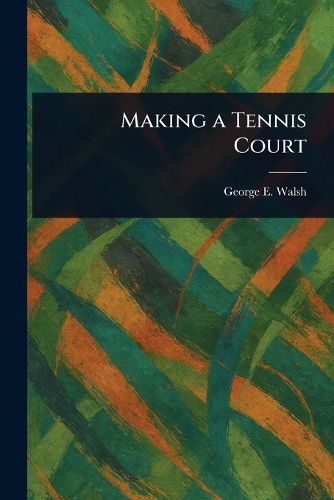Readings Newsletter
Become a Readings Member to make your shopping experience even easier.
Sign in or sign up for free!
You’re not far away from qualifying for FREE standard shipping within Australia
You’ve qualified for FREE standard shipping within Australia
The cart is loading…






This title is printed to order. This book may have been self-published. If so, we cannot guarantee the quality of the content. In the main most books will have gone through the editing process however some may not. We therefore suggest that you be aware of this before ordering this book. If in doubt check either the author or publisher’s details as we are unable to accept any returns unless they are faulty. Please contact us if you have any questions.
"Making a Tennis Court" by George E. Walsh offers a comprehensive guide to the construction of tennis courts, suitable for anyone interested in sports, recreation, or landscape architecture. This meticulously prepared reprint of a classic text delves into the practical aspects of building and maintaining lawn tennis courts. Explore the essential elements of civil engineering and design considerations necessary for creating a quality playing surface. Whether you are a sports enthusiast or simply intrigued by the technical details of recreational facilities, this book provides a valuable resource. Discover the historical methods and techniques used in constructing tennis courts, offering insight into a bygone era of sports and recreation. A fascinating look at the technology and applied science behind building the perfect tennis court.
This work has been selected by scholars as being culturally important, and is part of the knowledge base of civilization as we know it.
This work is in the public domain in the United States of America, and possibly other nations. Within the United States, you may freely copy and distribute this work, as no entity (individual or corporate) has a copyright on the body of the work.
Scholars believe, and we concur, that this work is important enough to be preserved, reproduced, and made generally available to the public. We appreciate your support of the preservation process, and thank you for being an important part of keeping this knowledge alive and relevant.
$9.00 standard shipping within Australia
FREE standard shipping within Australia for orders over $100.00
Express & International shipping calculated at checkout
This title is printed to order. This book may have been self-published. If so, we cannot guarantee the quality of the content. In the main most books will have gone through the editing process however some may not. We therefore suggest that you be aware of this before ordering this book. If in doubt check either the author or publisher’s details as we are unable to accept any returns unless they are faulty. Please contact us if you have any questions.
"Making a Tennis Court" by George E. Walsh offers a comprehensive guide to the construction of tennis courts, suitable for anyone interested in sports, recreation, or landscape architecture. This meticulously prepared reprint of a classic text delves into the practical aspects of building and maintaining lawn tennis courts. Explore the essential elements of civil engineering and design considerations necessary for creating a quality playing surface. Whether you are a sports enthusiast or simply intrigued by the technical details of recreational facilities, this book provides a valuable resource. Discover the historical methods and techniques used in constructing tennis courts, offering insight into a bygone era of sports and recreation. A fascinating look at the technology and applied science behind building the perfect tennis court.
This work has been selected by scholars as being culturally important, and is part of the knowledge base of civilization as we know it.
This work is in the public domain in the United States of America, and possibly other nations. Within the United States, you may freely copy and distribute this work, as no entity (individual or corporate) has a copyright on the body of the work.
Scholars believe, and we concur, that this work is important enough to be preserved, reproduced, and made generally available to the public. We appreciate your support of the preservation process, and thank you for being an important part of keeping this knowledge alive and relevant.